When it comes to our senses, we humans rely very heavily on our vision. However, dogs place far more emphasis on their sense of smell. And the reason that they do this is because their sense of smell, is, frankly, incredible!
As a result, Scent Training for Dogs is a fantastic activity for you and your dog.
Learn:
- How dogs are built to be good at nose work
- How a dog’s sense of smell is thousands of times better than ours
- How to do build a strong bond with your dog doing what he loves
- And … how to begin scent training for your dog
Affiliate Disclaimer
1 How Dogs Smell – Anatomy, Physiology, and Olfaction
Don’t be put off by the terminology!
I’ll keep it relatively brief but, I think it’s useful to understand why dogs have such a fantastic sense of smell.
If you aren’t interested in the ‘How‘ part you can skip to the next section.
Let’s start by examining a dog’s anatomy (the internal and external physical elements of the body) and physiology (the functions of those physical elements) in relation to canine olfaction (a dog’s sense of smell).
The key elements of the olfactory system are:
- Nasal cavity
- Olfactory epithelium and receptors
- Vomeronasal organ
- Olfactory bulb
The nasal cavity is made up of 2 chambers that are separated by the septum. These can be seen in the cross-section image below.
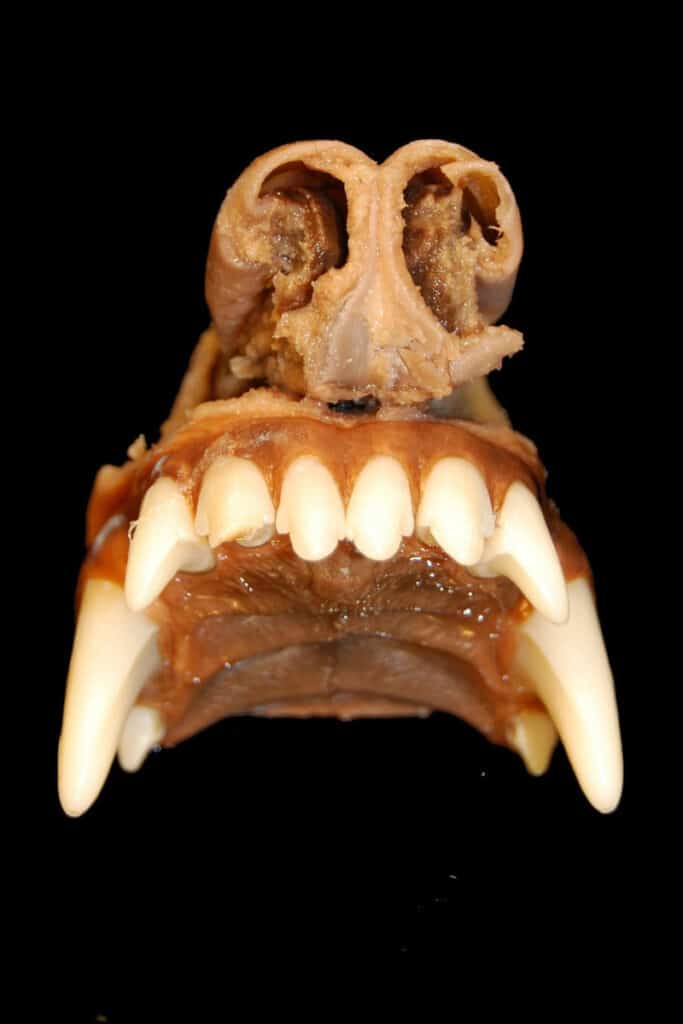
Each of these chambers contains structures called turbinates that are designed to increase the available surface area. These turbinates contain a network of veins.
When air is inhaled it passes over the turbinates.
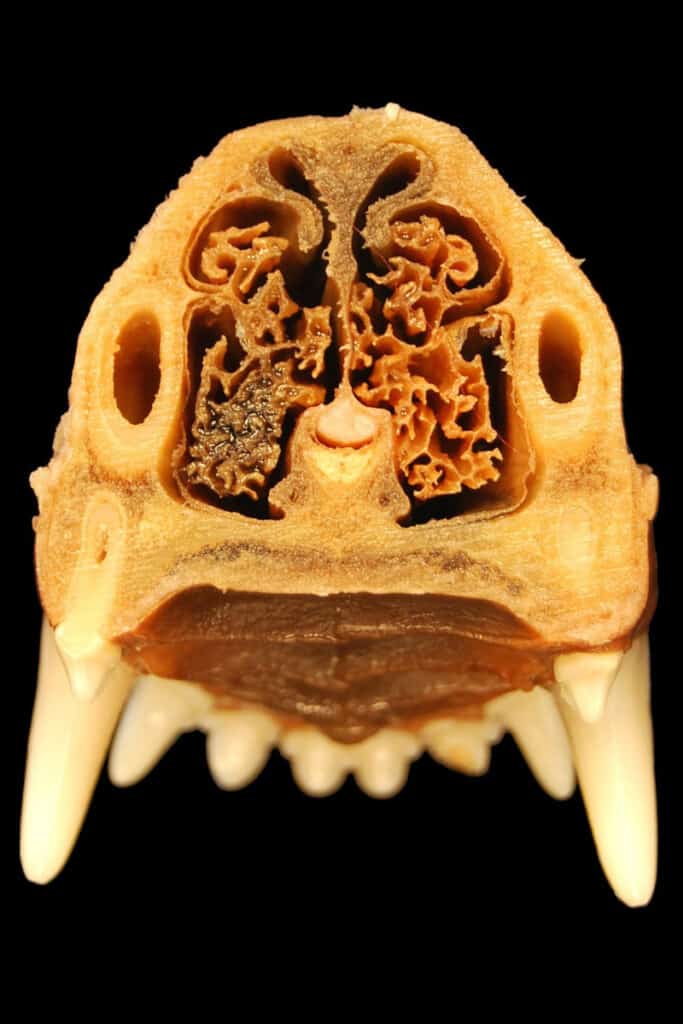
And, what is really impressive is that dogs can smell separately with each nostril. So, in much the same way as our brains use the information from our 2 eyes to form a 3-D image, a dog is able to use these 2 scents to determine the location of the source.
Furthermore, dogs are able to determine the relative concentration of odours. This enables them to effectively age odours (newer ones having stronger concentrations) and thereby determine the direction of travel for the source of the odour.
It is this ability that makes dogs so remarkable at tracking.
The olfactory epithelium contains millions of olfactory receptor cells (ORCs). These ORCs are linked to the olfactory bulb. The ORCs are responsible for detecting small concentrations of scents.
The olfactory bulb is a cortex of neural tissue that is responsible for processing the scents that are detected.
Scent information passes from the olfactory bulb to:
- Limbic system (primitive part of the brain). This deals with things like emotions, memory, and behaviour).
- Cortex (the complex, thinking part of the brain). This deals with conscious thought.
- Taste sensory cortex. This deals with how things taste to a dog, ie flavour.
The vomeronasal organ is effectively an additional source of scent detection. It is especially linked with scents such as pheromones and so has a role to play in a dog’s social behaviour.
What’s more, it allows dogs to detect human emotions, including fear:
“That dog don’t like me.”
“He’s alright, he can smell fear.“
“I’m surprised he can smell anything at all with that gallon of Brut you’re wearing.“
Rodney and Del Boy (Only Fools and Horses)
In the diagram below you can see the location of:
- Olfactory bulb
- Olfactory epithelium
- Respiratory epithelium
- Vomeronasal organ
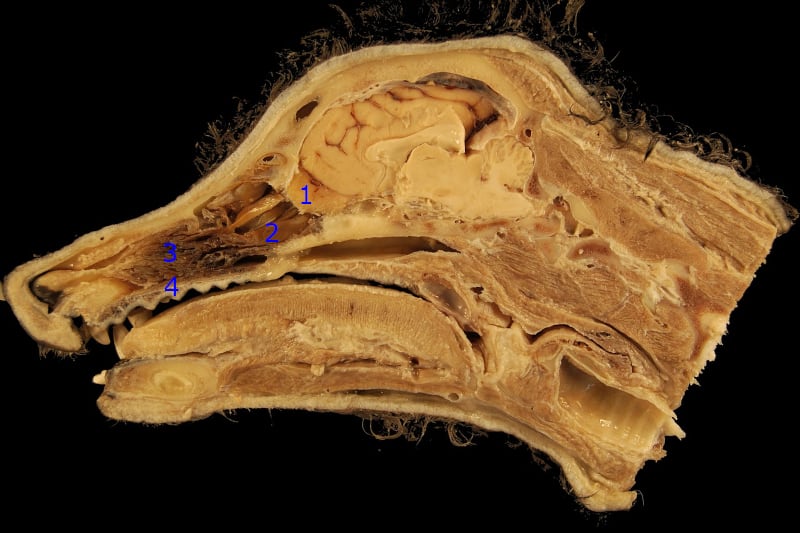
As a further string to their already impressive bow, dogs are able to separate air such that a part of it goes to the olfactory sensing area and a part is used for breathing.
Not only that, they can actually breathe in and out at the same time! (Go on, admit it. You just tried to do that, didn’t you?!)
Still with me?
Struggling to imagine everything even with the pictures?
For an excellent overview take a look at the short video below. It’s produced by the brilliant Alexandra Horowitz.
2 Scent Detection – Man vs Dog
So, we’ve seen how a dog’s anatomy is used in scent detection but just how good is it compared to our own?
You’ll remember ORCs and their role from the previous section. Humans have around 6 million of these. That sounds like a lot, doesn’t it?
Until you realise that dogs have up to 300 million!
Relative to total brain size, a dog’s olfactory bulb is 40 times larger than in humans!
Overall, scientists estimate that a dog’s sense of smell is roughly 10,000 – 100,000 times better than that of a human.
That’s quite difficult to comprehend for a creature with sight as its dominant sense so let’s put it in visual terms.
“Let’s suppose they’re just 10,000 times better. If you make the analogy to vision, what you and I can see at a third of a mile, a dog could see more than 3,000 miles away and still see as well.”
James Walker
(former director of the Sensory Research Institute at Florida State University)
Or …
Studies at the University of Adelaide found that dogs can smell objects or people as far as 20km away.
Or …
The fact that dogs can actually use scent to determine what time of day it is!
Ever wondered how your dog ‘knows’ when it is meal time? Or walk time? Or bedtime?
Well, Alexandra Horowitz believes that dogs are able to use their sense of smell to determine the time of day. She explains better than I could:
“Smells in a room change as the day goes on. Hot air rises, and it usually rises in currents along the walls and will rise to the ceiling and go kind of to the center of the room and drop. If we were able to visualize the movement of air through the day, what we’re really visualizing is the movement of odor through the day.“
Alexandra Horowitz
There can be little doubt that, when it comes to scent detection, dogs will beat humans all day, every day. And it’s not even close!
But are all dog breeds equally adept at nose work?
Well, no. All breeds are better than humans but some breeds are much better than others, primarily based upon the number of ORCs that they have.
The top 5 are:
- Bloodhound (300 million ORCs, used in scent detection for many years)
- Basset Hound (long ears help to direct smells to the nose)
- Beagle (often used as detection dogs at airports)
- German Shepherd (225 million ORCs, a favourite with the military and police)
- Labrador (impressive scent detection ranging from bombs to cancer cells)
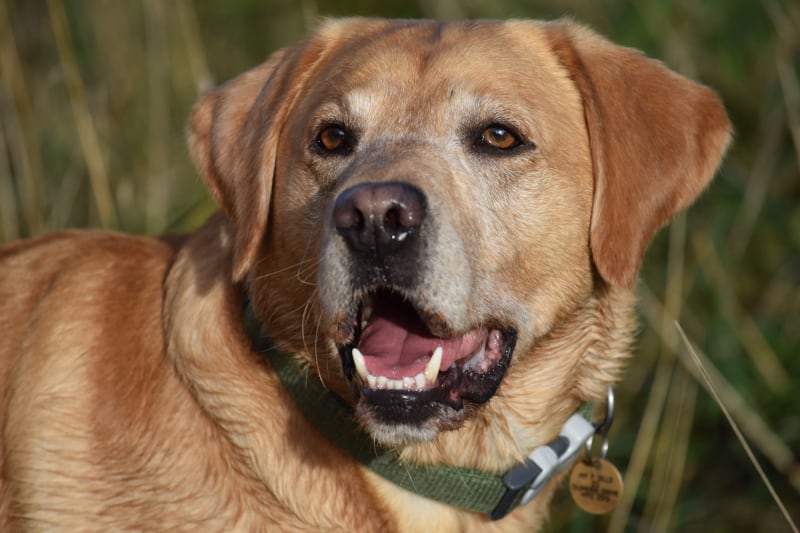
3 Uses for Dog Scent Detection
OK, we’ve looked at how a dog’s sense of smell works.
And marvelled at just how impressive it is compared to our own.
Now let’s take a look at what uses there are for this tremendous ability if we make use of scent training for dogs.
In their study titled Canine Olfaction: Scent, Sign, and Situation (2014) the authors (Simon Gadbois and Catherine Reeve) categorise types of scent work based upon the area of the brain that is primarily used.
| WHAT | WHERE | HOW MUCH |
|---|---|---|
| Detection | Searching | Scaling |
| Discrimination | Trailing | |
| Identification | Tracking | |
| Pyriform cortex | Entorhinal cortex | Olfactory bulb |
- Detection: The identification of one stimulus, or stimulus category, among background noise or interference.
- Discrimination: The identification of one stimulus, or stimulus category, as contrasted to another often similar stimulus or another category.
- Identification: This process requires a more explicit knowledge of the stimulus. For example, matching-to-sample tests.
- Searching: Looking for a stimulus that has not yet been detected.
- Trailing: Here, cues have been detected indicating the presence of the stimulus but it has not yet been localised.
- Tracking: Here, the target stimulus has been acquired and a path to the stimulus has been identified and is being followed.
- Scaling: In some scenarios it is useful to assess the quantity of scent molecules present in the environment.
Looking at these categories I’m sure that you have already thought of some areas where scent training for dogs can be used to great effect to assist us humans.
Here are a few:
3.1 Law Enforcement
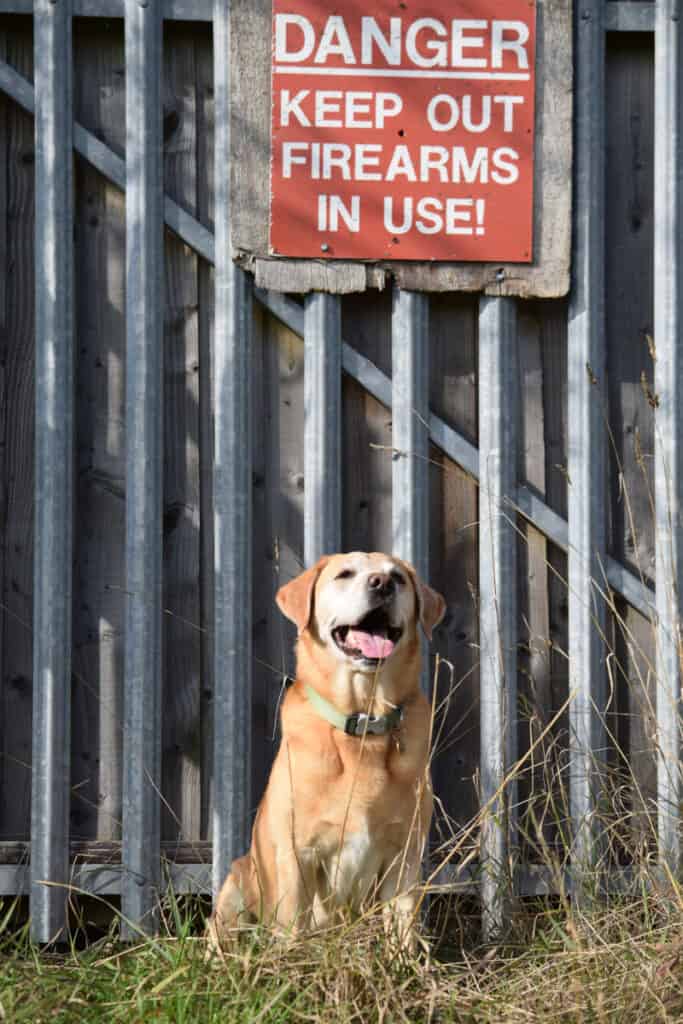
Police frequently train dogs to detect illegal substances and items.
These dogs then work in a variety of scenarios to locate these substances such as airports, border crossings, seaports, train stations, large public events, even workplaces and schools.
The targets include explosives, narcotics, arson materials, and firearms.
There are also cadaver dogs – those trained to locate human remains. These dogs can even locate bodies buried underground or submerged underwater.
3.2 Medical
Studies regularly show that the accuracy of a dog’s scent detection can rival, and often exceed, the abilities of machinery custom-built for the purpose of detecting various illnesses.
Covid-19. Yes, in remarkably quick time, in preliminary tests dogs have already been trained to be able to distinguish urine samples from Covid-19 patients from urine samples of healthy individuals.
Lung cancer. In a 2019 study by Heather Junqueira et al, dogs were able, with 96.7% accuracy, to distinguish between blood samples from patients with lung cancer and samples from healthy control subjects. An earlier 2012 study by Boguslaw Buszewski et al found that dogs were able to identify the presence of lung cancer by smelling breath samples.
Prostate cancer. A 2021 study by Claire Guest et al looked at the ability of dogs to identify prostate cancer by reviewing urine samples.
Skin cancer, breast cancer, ovarian cancer, and bladder cancer can also be detected by dogs.
Diabetes. Evidence is only anecdotal at this stage but it is believed that dogs may be able to determine when impending hypoglycemic events are about to happen in diabetic individuals.
Other areas include: malaria, clostridium difficile.
3.3 Conservation
Scent detection dogs play a valuable role in wildlife conservation.
In urban environments, they can be used to locate endangered animals that may be at risk of losing their habitat during building projects.
Even if the target animal is underwater! Like, say, Killer Whales!
In the UK, for example, dogs have been used to locate bats, hedgehogs, and dormice. (A 2015 study by Carol L Chambers et al found that dogs had a high detection success rate).
In rural, and even jungle!, environments dogs can be hugely valuable in locating endangered species. This can be very helpful in enabling those protecting the animals to find them before the poachers do.
To teach a dog to locate a particular scent you obviously need a way of exposing him to that scent in order that he becomes familiar with it.
However, if your intended target is a rhinoceros this could be dangerous for both dog and handler. Likewise other endangered species.
Or the target may be scared, or at least wary, of the dog.
So what do you do?
You use something that you will find in every location that the animal has visited … dung!
That’s right. Dogs are trained to recognise the scent of the dung for the animal that they are looking for.
3.4 Search and Rescue
Whether it’s a walker that’s become lost on a range of hills, a family buried alive after an earthquake, or office workers trapped in rubble after a terrorist attack, among the first on the scene are Search and Rescue.
And key members of the SAR team are the dogs.
The fantastic scent abilities of these dogs enable them to locate people much more quickly than human-only teams would be able to. And in SAR scenarios that speed could make all the difference.
And if you ever wondered whether dogs are impacted by the dreadful scenes that they sometimes face … they are.
After looking for survivors in the aftermath of 9/11 many handlers and dogs became depressed. They are trained to find survivors but in this case, there were few survivors and many fatalities.
3.5 Enjoyment!
Scent work is a natural behaviour for dogs. The sense of smell is their primary sense and the way in which they ‘see’ the world.
The sense of enjoyment in a dog tracking, and locating, a scent is really something to behold.
It is, of course, closely linked to marking behaviour in dogs. Just as we need to be able to read and write in order to communicate, a dog needs to be able to both smell scent and deposit it.
Not only that, but it also induces an optimistic attitude and improves general welfare.
4 Scent Training for Dogs
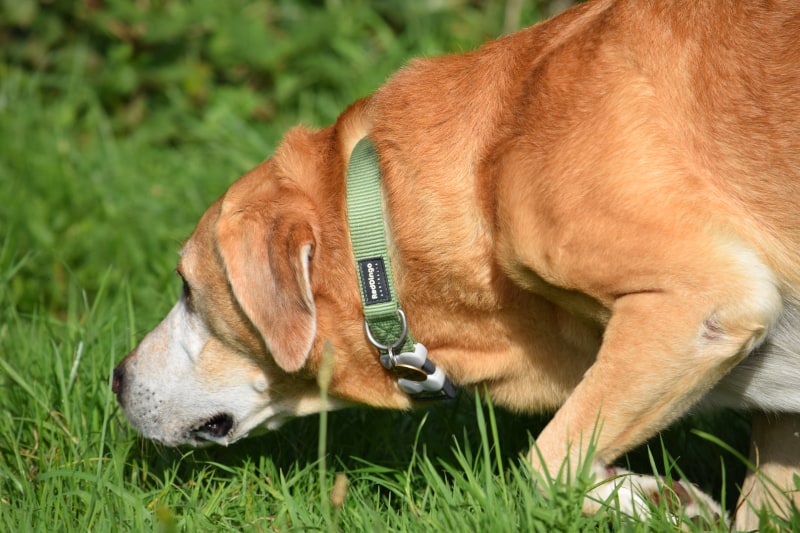
OK, so we’ve looked at:
- The anatomy and physiology of dogs to see how they sense of smell works
- A comparison of the sense of smell in dogs and humans (dogs=great, humans=rubbish!)
- The great variety of uses to which we can put this incredible ability
Let’s now move on and see how we go about developing this ability with Scent Training for Dogs.
This will be basic training for somebody looking to start with scent work. It won’t produce one of the wonder dogs described in the previous section. Although there is nothing stopping you from working towards that …
4.1 Choice of Scent
We could, in theory, use pretty much any scent and our dogs would be able to detect it.
However, it’s preferable to use something that the dog wouldn’t normally come across in his daily routine.
Common choices are:
- Truffle oil
- Birch oil
- Anise
- Clove
- Catnip
- Gun oil
4.2 Equipment for Scent Training
A key consideration with scent training for dogs is the avoidance of scent contamination.
For example, if we have chosen truffle oil as our target scent we don’t want there to be any other scents mixed with it which may lead to our dog learning to track the wrong scent.
Therefore, much of the equipment needed for scent work is based upon this need to avoid contamination.
So, here is what you’ll need:
- Your chosen scent. For example, truffle oil. The item linked to is well reviewed on Amazon. However, truffle oil can be quite expensive so shop around – you may well find a similar, cheaper product on Amazon or at your local supermarket.
- A soak of some sort. A soak is basically an absorbent material that is used as the carrier for the scent. We will want to refresh these on a regular basis so the usual choices are cotton pads or cotton swabs (like the ones that you use to clean your ears!).
- To avoid contamination while preparing for scent work it is helpful to wear disposable gloves and to use tweezers for handling the soaks.
- A container for the soak. Typical containers are tins with screw lids (you will need to drill some holes into the lid for scent ventilation) and mesh ball tea strainers (I kid you not!).
Note that it is advantageous to vary the containers that you use so that the dog learns that it is the scent that it is looking for, not a particular container type. - You’ll also want a long line. When your dog is pursuing a scent you don’t want to be hampering his progress by keeping him on a short lead. Therefore, it’s best to attach a long line and let your dog have some slack to do his thing.
- If you don’t already have one you should also get a harness for your dog. Long lines should not be attached a normal collar as there is too much potential for your dog to suffer neck and throat injuries.
In fact, if you decide that you like doing scent work with your dog then, even if you already have a harness it’s a good idea to have a separate one for scent training as this helps the dog to associate having that harness on with doing scent work. It’s similar to guide dogs knowing that they are ‘working’ when their work harness goes on.
If you don’t already have a harness, note that there are a huge range of styles and manufacturers.
The most important aspect is that it is a comfortable fit for your dog. Too loose and the harness will soon come off your dog. Too tight and it will be uncomfortable, possibly rubbing sores and at the very least making your dog reluctant to wear it.
If you buy from a store then get the owner to help you and have your dog try a few for fit. If ordering online make sure that you have carefully measured your dog before picking the appropriate size.
For everyday use with Harvey we have a Perfect Fit harness which we are very pleased with and have had for many years. For scent work we use a Haqihana harness.
4.3 Basis of Training
In case you didn’t already know – dominance theory is dead!
Please don’t intimidate your dog by trying to ‘be the Alpha’, ‘be the Leader of the Pack’, or ‘show him who is boss’.
I strongly encourage you to make use of Positive Dog Training principles.
And one of the key aspects of rewarding your dog is knowing what your dog values most. Is it a particular flavour of treat? Some warm roast chicken? Or a favourite toy?
I think that the ideal is a toy that you have solely for rewarding in scent work. This means that its value is reserved for that task only and so remains a special reward for your dog.
When training a particular skill it’s often preferable to see whether it can be broken down into a number of small tasks. Once learned, these smaller elements can then be combined to achieve the overall objective.
Scent training for dogs can be broken down into 3 stages:
- Imprinting the target scent.
- Teaching the ‘Found It!’ indication.
- Searching for the scent.
4.4 Scent Imprinting
Ready!
Let’s get started …
So, how do we tell our dog what it is we want him to find? We imprint the scent in his memory.
In order to do this, we’ll let our dog smell the chosen scent and then immediately reward the behaviour with some tasty treats. This is the basis of positive training – the dog comes to associate the scent with something good happening.
The more that this process is repeated, the stronger the imprinting will be. And the stronger the imprinting, the more that our dog will actually want to find the target scent.
Here’s the plan:
- Remember that we want to avoid scent contamination. So, the first step is to put on a pair of disposable gloves.
- Then take your tweezers, pick up the chosen soak, and dip it in the chosen scent (a few drops will suffice – remember how good your dog’s sense of smell is, we don’t want to overload it!).
- Place the soak into the container.
- Hold the container in one hand and allow your dog to approach it.
- As soon as your dog sniffs the container immediately reward him, bringing your treat hand close to the scent container, with some good treats (not plain old kibble, something that he really likes).
- Repeat 5-10 times per session. If your dog is super-keen then do 10. If you think that he is likely to lose interest then it is better to successfully complete 5 and then stop.
- Repeat multiple times during the day. Repeat for at least a week.
4.5 Teaching the ‘Found It!’ Indication
Set!
It may seem an obvious point (I’m going to make it anyway!) but when we undertake scent training for dogs we need to have some sort of indication that lets us know when our dog has found the target scent.
Now, before we get started on training an indication, it’s worth mentioning that many scent work individuals don’t train an indication but rely instead on a change of behaviour.
They watch their dog very closely for indicators such as a sudden reduction in pace, or increase in pace, running back and forth across the same area, head and tail both held high, and so on.
Now, these changes of behaviour may work, but …
- They really require an experienced eye to spot and so aren’t ideal for beginners
- They aren’t as reliable as a trained indicator
There are a variety of indicators that can be used. We could use: sit, stand, down, nose touch, or something more active like scratching, biting, or barking.
We want to maintain that ‘Woohoo!’ initial enthusiasm that our dogs have for scent work. Therefore, I’d stick with the easier active indicators initially. Once you’ve progressed a little you can move on to the more difficult passive indicators.
So, set up a scent container in a hidden location (remember to avoid scent contamination), be that in your house or garden, put on your dog’s harness and lead, and give the cue ‘Search’ (or whatever you choose – the word itself isn’t important, but be consistent).
When your dog finds the scent container, take note of how he signals that he has found it (prolonged sniffing, pawing/scratching etc) and immediately reward him with your chosen reward.
Repeat 2-3 times more to make sure that your dog ‘gets it’.
Excellent. Your dog now recognises the scent, can find it and can indicate its location.
Once you have been training for a while come back to this section and take a look at the video below where Carla Simon talks about training an indication. This is the next step in the training process.
4.6 Searching for the Scent
Go!
OK, the preparation is complete. We’re now ready to do a proper field test. (You can even do your field test in a field if you have access to one!)
It’s probably easiest at this stage if you can enlist the services of a willing helper to hide 1 or 2 scent containers in the chosen area (choose a relatively small area initially) while you and your dog cover your eyes! That way, you won’t know where the containers are either and will have to rely on your dog telling you.
Give your chosen cue, such as ‘Search’, and set off on your first proper test.
If you are in a relatively small area you can allow your dog a lot of freedom to locate the scent and just follow after him looking for an indication.
However, if you start working in a larger area you need to be a little more methodical. You will want to mentally picture a number of search zones within the overall search area and sweep through these with your dog.
Imagine a series of horizontal bands, work across one band from left to right and then at the end of the band move up to the next one and work back from right to left.
And, just as you did when working with the scent indication, make sure that you really reward your dog well when he does lead you to the scent container. Remember – this is the exact behaviour that we wanted! Let your dog know that!
5 Fun Scent-based Games
The following are a small collection of scent-based games just for fun. We aren’t using the chosen scent from above or any of the measures to avoid scent contamination.
5.1 Pick the Correct Hand
Equipment needed: Tasty treats.
I’m sure you’ve played variations of this game before.
For the initial runs of the game, take a single treat in one hand. Close the hand into a fist, palm down. With your dog sitting in front of you, present the hand and say ‘Find It!’. Your dog will sniff your hand. As he does so, say ‘Yes!’ (or ‘Yay!’ or ‘Good!’ or whatever you want but stick with the same word) and open your hand to let him have the treat.
After a few repetitions, start using two hands; one with a treat and one without. When she sniffs the correct hand … Yes! … treat. Eventually, your dog will start to go to the correct hand immediately. (It won’t be 100% successful as this is just for fun and there is bound to be residual scent on both hands after a few repetitions.)
For added difficulty, add in an extra person (or more) for additional empty hands!
5.2 Muffin Tin and Tennis Balls
Equipment needed: Muffin tin, tennis balls – enough to match the number of muffin spots in the tray, (bet you guessed those two!) tasty treats.
Take the muffin tray and put a treat in a couple of the indentations. Then put a tennis ball in all of the indentations (covering the treats in the couple selected).
Put the tray on the ground and ask your dog to ‘Find It!’. Your dog should be able to tell where the treats are hidden. Most will remove the blocking tennis ball and take the treat as their reward – others may need a little help to start with.
5.3 Shell Game
Equipment: 3 plastic containers (shells), tasty treats
You may have seen a version of this game played on street corners where it is often used as a confidence trick to cheat people out of money when they try and guess which shell the ball is under. The ‘dealer’ invariably uses sleight of hand to fix the outcome in his favour.
Needless to say, we won’t be trying to con our dogs (thinking about it, with their sense of smell I’m not sure that we could!).
In our version of the game, we’ll be placing a treat under a container and asking our dog to ‘Find It!’. Start with one container, just to get the dog used to what is expected. After a few repetitions add another container. When your dog can reliably pick the right container you can then add a third container. (And even a fourth).
5.4 Box Search
Equipment: A cardboard box (preferably with some of that loose paper that is often used as packing when items are posted), tasty treats.
Take an empty cardboard box, add some paper stuffing, and place some treats inside the wrapping. Then fold the leaves of the cardboard box such that it is loosely sealed again. Now give the ‘Find It!’ cue to your dog.
As I observed in my Christmas Presents for Dogs post, cardboard boxes are awesome! Most dogs have great fun playing with a cardboard box, especially if there are treats inside that they can smell.
5.5 Hide and Seek
Equipment: A willing helper!
The next time that you visit a suitable location (woods and forests are ideal because of the tree cover) with your dog and a friend, consider a quick game of ‘Hide and Seek’.
Ask your friend to hold your dog while you go and hide. After an agreed amount of time, your friend can release your dog and say ‘Where’s Richie? Find him!’. Obviously, you’ll have more success if you swap ‘Richie’ for your name!
When your dog finds you, a suitably enthusiastic greeting and a few treats would seem like an appropriate reward.
5.6 Find the Treats
Equipment: Tasty treats
This one is very simple (not that the others have been complicated!).
Put your dog in a Down so that they will wait while you set this up.
Take a collection of treats and hide them in various places around your house. Be sensible! Don’t put them where they can’t be reached, where there is any danger from appliances, or near any breakables that you don’t want to be broken (if they do break anything, it’s your fault, not your dogs!). You can use different heights and you can put them under things.
Release your dog from his Down with a ‘Find It!’ and watch as he goes around the house searching for the treats.
We play this 3 or 4 times a week with Harvey as he absolutely loves this game. He’s fast too!
6 Frequently Asked Questions
Here are some FAQs related to [this blog topic]
The Top 5 are generally considered to be: That said – any dog will have a far better sense of smell than a human! It’s all to do with a dog’s remarkable sense of smell. Having a thin coating of mucus on its nose means that scent particles will be captured there. Almost certainly not! Scent training can be done at your dog’s own pace. Just give some advance thought to both the duration of a training session and how much distance will be covered. First, you’ll need some basic equipment – this includes the scent to be searched for and some scent containers. There are many, many scent-based games but the classics remain popular:What Dog Breed has the Best Sense of Smell?
Why do Dogs have Wet Noses?
Is my Dog Too Old for Scent Training?
Don’t rely on signals from your dog as to when it is tired – dogs are very stoic and will keep going long after they should really have stopped!How do You Start Scent Training for Dogs?
Second, applying positive dog training principles, you need to do some scent imprinting work to help your dog ‘learn’ the target scent.
Third, is teaching your dog a reliable ‘Found It’ indication.
Fourth – start searching!What Scent-based Games can Dogs Play?
* The Shell Game – 3 containers, a treat hidden under 1, move the shells around and then ask your dog to pick the one with the treat under it.
* Hide and Seek – have somebody hold your dog while you go and hide, once you are ready your dog is released to come and find you. Works well in woods and forests.
7 Acknowledgements
Image acknowledgements:
And …
8 Shopping List
For your convenience, all of the linked-to items are included here in one place, together with an image.
Shopping List
Truffle Oil
This is what we have chosen as our scent.
We will only be using a few drops at a time so don’t feel that you need to buy a large bottle – a small one will suffice for now.
Cotton Pads
Cotton pads are a good choice for our soak (scent carrier).
We will be refreshing the soak on a regular basis so buy plenty.
Cotton Swabs
Cotton swabs are another good choice for our soak (scent carrier).
As with the pads, we will be refreshing the soak on a regular basis so buy plenty.
Disposable Gloves
Wearing gloves enables you to handle the various items of scent equipment without the risk of adding any scent particles that are already on your hands.
Tweezers
Using tweezers to handle the soaks reduces any cross-contamination risk still further.
Metal screw-lid container
We need to place the scent soak into a container of some kind before hiding it – these are ideal once some holes are drilled into the lid.
Mesh Tea Strainers
Another container suggestion for holding the soak is a mesh ball tea strainer! No drilling is needed with these and the little chains can come in useful for hanging them in chosen locations.
Long Line
Don’t cramp your dog’s style!
Having a long line will allow your dog to pursue the scent without having to stop every 2 seconds for you to catch up!
Harness
Don’t risk injuring your dog by attaching a long line to his collar – use a harness!
9 The End
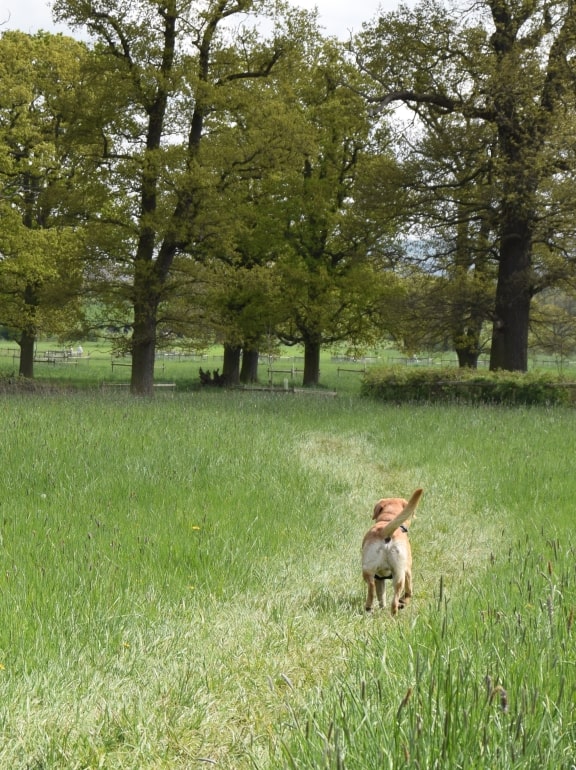
I hope that you’ve enjoyed this post.
Feel free to navigate around the site to see if there is anything else that may be of interest to you.
If you liked this post please share it. Thank you 🙂
If you’d like a heads-up when the next post is issued sign-up to the Richie’s Room Newsletter.
And, if you’d like to add a comment that would be great too – you can do that below.











I feel like I’ve learned quite a lot here! Lots of things I genuinely didn’t know! Thank you!
Hi Amie. I’m glad to hear that – blogging is all about education and entertainment as far as I’m concerned 🙂
Very thorough read. I saw where I think in Miami they were using dogs to smell people who had Covid. It’s so weird what they use their nose to tell them.
Thanks for your comment, Greg. Yep, their sense of smell is truly incredible.
Thanks for sharing this Richie. I’ve learnt so much, for example I had no idea dogs could use each nostril individually. We have a beagle and although they’re supposed to be great sniffers, I’m sure ours didn’t get the memo!
Claire.
Hi Claire. I’m glad that you’ve learned lots. Don’t give up on your Beagle – try some of the games suggested at the end … 🙂
This is fascinating – I’ve never had dogs so my knowledge is pretty limited but you’ve included so much for me to learn. The individual nostril use is so surprising – I had no idea!
Thanks very much for your feedback, Alice, I’m glad that you’ve learned something from the post.
As you know, we don’t have dogs, we have cats but much of what you’ve written is applicable to felines as well, I’m sure. The notable difference being cats are less willing to be trained than dogs! That’s fascinating about individual nostrils though, I wonder if cats are the same? I’ll have to look it up 🙂
Thanks very much for your feedback, Lisa. If I can get cat lovers to read a dog post then I must be doing something right! 😉
(To be fair, I love cats too!)
A really interesting post about scent training for dogs, there’s so many factors that goes into the training! x
Lucy | http://www.lucymary.co.uk
Thanks very much, Lucy. Yes, there is a lot to consider – but it’s quite simple to get started, really. 😉
My sister does a bit of this in her day job and it always fascinates me!
Rosie
Hi Rosie. Thanks for your comment. Does your sister use scent detection dogs for her job or is she a trainer?
Thank you for sharing this informative post, Richie! I’ve always known dogs have a great sense of smell, but this article has taught me so much. It was a great read! 🙂
Hi HDC. I’m glad that you found the post to be informative and a great read. Thank you.
Doggos never cease to amaze me — thanks for the info, it really does make me appreciate how they sense the world around them.
Hi Molly, thanks for your comment. They really are incredible, aren’t they?
Dogs, just like polar bears, are incredible sniffers. I think I feel safer around dogs though.
Hi Jamie. Thanks very much for the feedback. Polar bears, huh? Yeah, I don’t fancy training one of those … 😉
I own a miniature schnauzer dog and her sense of smelling is incredible! Thanks for sharing this article, gained a lot of insights from this!
Hi Anna. Thanks for your comment – I’m pleased that you gained a lot of insights from the post.